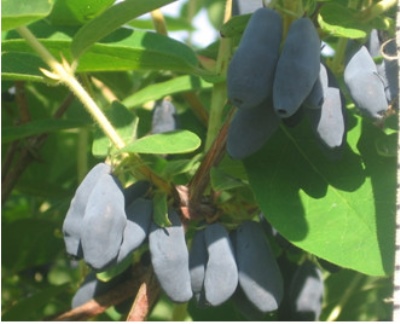
- Authors: Gidzyuk Ivan Karpovich, Savinkova Nadezhda Viktorovna, Pavlovskaya Anna Petrovna (Bakcharsky stronghold of northern gardening named after M.A.Lisavenko at NIISS)
- Appeared when crossing: Kamchatka x Turchaninova
- Year of approval: 2013
- Growth type: medium-sized
- Description of the bush: medium spreading, sparse
- Bush height, m: 1,6-1,8
- Escapes: medium, straight, brown-red, hairless
- Leaves: medium, green, oval, matte, leathery, smooth
- Crown: oval
- Flowers: medium, pale yellow
In the temperate climate of the Northern Hemisphere, a culture such as honeysuckle is very common. Its wild edible fruits, although sour and small, have unique medicinal properties. But only in the middle of the last century, this was noticed, and professional breeders became seriously interested in the culture. A large number of cultivars with excellent qualities have appeared, including the Bakcharskaya Jubilee honeysuckle variety.
Breeding history
An interspecific hybrid from Turchaninov's honeysuckle and the Kamchatka variety was obtained at the Lisavenko Bakcharsky stronghold of northern gardening at NIISS, in the well-known forge of Siberian varieties of fruit crops. Experienced breeders worked on the creation of the variety:
- Gidzyuk Ivan Karpovich;
- Savinkova Nadezhda Viktorovna;
- Pavlovskaya Anna Petrovna.
In 2006, the variety was accepted for the state test, which was successfully passed. The culture was included in the lists of the State Register for the Russian Federation in 2013.
Description of the variety
The bush of Bakchar jubilee honeysuckle is medium-sized, grows to a height of 160–180 cm, not very sprawling, oval in shape. The color of the smooth shoots without pubescence is brown-red, they grow straight. Shoots are lignified, which is typical for culture. On the branches, green sparse foliage, straight leaf plates of medium size, oval, matte, medium pubescence.
The flowers are small, pale yellow. On the branches, the ovaries, and then the fruits, are arranged in clusters, in groups of numerous berries, which increases the convenience of collection. Mechanized harvesting is possible.
Fruit characteristics
Bakchar jubilee is distinguished by large fruits. They grow in length up to 3.3 cm, in diameter 1.2 cm.The berry weight can vary from 1.4 to 2.1 g. They are elongated-oval, the top of the berries is rounded, they are painted in a dark blue tone, there wax bloom. The berries are medium fixed on the branches, do not crumble, and they are easy to pick.
Taste qualities
The fruits of the considered honeysuckle taste sweet and sour, juicy, there is no bitterness, but there is a refreshing aroma. The tasting score is very high: 4.8 points. The purpose of the berries is universal.
Ripening and fruiting
The culture is early-growing, begins to bear fruit as early as 2-3 years of life, then annual fruiting. In terms of ripening, it belongs to medium-late varieties.
Yield
The described crop is a high-yielding variety. On average, 1 bush brings 3.5 kg of berries. On an industrial scale, this figure is 106 c / ha.

Growing regions
Bakcharskaya jubilee will feel great almost throughout the country, but it grows best in the moderate climatic conditions of the middle zone, as well as in the East Siberian and Far Eastern regions.
Self-fertility and the need for pollinators
The described culture is self-fertile. To get a good harvest, you need to plant several honeysuckle bushes nearby. According to the observations of gardeners, Silginka will become the best pollinator of the Bakcharskaya jubilee.
Growing and care
Honeysuckle is not a very whimsical culture, and the Bakcharskaya Jubilee variety is no exception. The only requirement is sufficient illumination of the place where the bush grows, if there is little light, a large collection will not work, and the berries will grow small. And you can't plant a crop in low-lying places, where cool air accumulates, and there is stagnation of water. Any soil is suitable, but it will still be better if the land on the site is fertile and loose.
The culture is planted both at the end of summer and at the beginning of autumn, so that the bush has time to acclimatize and get stronger before the cold weather. In spring, only container plants can be planted.
When planting several bushes, they are placed no closer than 1.5 m to each other or from other trees. Bakchar jubilee grows with time, and it needs a place. Therefore, it is necessary to maintain a distance of 2.5 m between the rows.
Care is necessary only for young honeysuckle seedlings, literally in the year of planting in the ground. The rooted Bakcharskaya jubilee practically does not require attention to itself.


Disease and pest resistance
Like all honeysuckle, the culture in question is not affected by diseases and pests.

Winter hardiness and the need for shelter
The culture is winter-hardy, drought-resistant and heat-resistant. As for cold resistance, Bakcharskaya Jubilee can withstand temperature drops to -48 ... - 56 ° C without any problems, and flowers do not fall even at -7 ° C.
































































